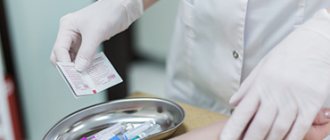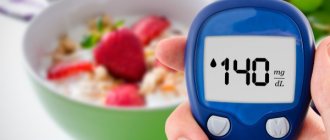Methods for determining blood sugar levels (how blood is donated for sugar)
There are several ways to determine your blood sugar level:
- Determination of sugar level in capillary blood (in blood from a finger). Capillary blood is a mixture of the liquid part of the blood (plasma) and blood cells. Blood is drawn in the laboratory after a puncture of the ring or any other finger.
- Determination of sugar level in venous blood plasma . In this case, blood is taken from a vein, then it is processed, and plasma is released. A blood test from a vein is more reliable than from a finger, since pure plasma without blood cells is used.
- Using a glucometer . A glucometer is a small device for measuring blood sugar levels. It is used by patients with diabetes for self-control. Glucometer readings cannot be used to diagnose diabetes mellitus, since it has a small error depending on external conditions.
Causes of low sugar
A reduced concentration of sugar in the blood serum is a rather rare phenomenon, which in professional language is called hypoglycemia. Typically, hypoglycemia occurs against the background of such pathological processes:
- the formation of tumors of benign or malignant origin in the pancreas;
- hepatitis, accompanied by rapid destruction of liver cells;
- adrenal dysfunction;
- oncological processes in different organs;
- increased physical activity, fever;
- overdose of hypoglycemic drugs and insulin;
- long-term use of anabolic steroids.
Reduced glucose concentrations are often found in newborns. Most often this happens if the baby's mother has diabetes.
In adults, a strict low-carbohydrate diet can provoke a decrease in blood levels.
What you need to know to successfully donate blood for sugar
In order to take a blood sugar test, no special preliminary preparation is needed. It is necessary to lead your usual lifestyle, eat normally, consume enough carbohydrates, i.e. do not starve. During fasting, the body begins to release glucose from its stores in the liver, and this can lead to a false increase in glucose levels in the test.
It is advisable to take a blood sugar test, like all other tests, early in the morning on an empty stomach.
It is in the early morning hours (before 8 am) that the human body has not yet begun to work at full strength; organs and systems peacefully “sleep” without increasing their activity. Later, mechanisms are launched aimed at their activation and awakening. One of them is increased production of hormones that increase blood sugar levels.
Many people are interested in why a blood sugar test needs to be taken on an empty stomach. The fact is that even small amounts of water activate our digestion, the stomach, pancreas, and liver begin to work, and all this is reflected in the level of sugar in the blood.
By the way, we recommend reading the article What you need to know about tests for diabetes mellitus?
Not all adults know what fasting is. Fasting means not consuming food or water 8-14 hours before the test. As you can see, this does not mean at all that you need to fast from 6 pm, or even worse, all day if you are going to take the test at 8 am.
Basic rules of preparation
- do not fast beforehand, lead a normal lifestyle;
- before taking the test, do not eat or drink anything for 8–14 hours;
- do not drink alcoholic beverages for three days before the test;
- It is advisable to come for analysis in the early morning hours (before 8 am);
- A few days before the test, it is advisable to stop taking medications that increase blood sugar levels. This only applies to medications taken temporarily; there is no need to stop those you take on an ongoing basis.
Before taking a blood sugar test, you should not:
- Smoking. During smoking, the body produces hormones and biologically active substances that increase blood sugar levels. In addition, nicotine constricts blood vessels, which complicates blood sampling.
- Brush your teeth. Most toothpastes contain sugars, alcohols, or herbal extracts that increase blood glucose levels.
- Do intense physical activity, go to the gym. The same applies to the road to the laboratory itself - there is no need to rush and rush, forcing the muscles to actively work, this will distort the result of the analysis.
- Carry out diagnostic interventions (FGDS, colonoscopy, radiography with contrast, and even more so complex ones, such as angiography).
- Perform medical procedures (massage, acupuncture, physiotherapy), they significantly increase blood sugar levels.
- Visit the bathhouse, sauna, solarium. It is better to postpone these activities until after the analysis.
- Be nervous. Stress triggers the release of adrenaline and cortisol, which raise blood sugar levels.
High or Low Sugar: Symptoms and Measurement
The main hormone that can regulate sugar levels is insulin. Its secretion increases with increasing glucose levels. Blood sugar levels decrease after the body's cells consume it, resulting in stimulation of glycogen synthesis within the liver. When glucose enters the body, it is broken down inside the stomach and then goes to the cells.
In the presence of great stress or disruption of the hormonal system, the metabolic process may be disrupted, so the sugar level will also change. If it is underestimated, then the cells of the body are in a state of energy starvation and the period of their being without nutrients is extremely short. In this case, brain cells are considered the most vulnerable, since they most need a constant flow of useful substances.
Signs of decreasing blood sugar levels, called hypoglycemia, include increased sweating, feelings of hunger, rapid heartbeat, trembling and nausea, unmotivated anxiety, and paresthesia of the skin on the lips. If the cells do not receive the necessary glucose on time, then headaches, drowsiness and weakness, blurred vision, inability to navigate in space, and confusion may occur.
When blood glucose levels rise and this process is not regulated by the body, a person will immediately feel certain symptoms. If this occurs due to insulin deficiency, the disease is called diabetes mellitus. It is distinguished by a physiological increase in indicators and a pathological one. Symptoms of diabetes mellitus include: increased urination, polydipsia (thirst, lack of water), polyphagia (or constant desire to eat).
- 11 categories of drivers who are exempt from transport tax
- How to care for slime
- Benefits for pensioners to pay for utilities - who is entitled to, the amount of compensation and subsidies
Glucose tolerance test
To clarify the diagnosis, some patients are prescribed a glucose tolerance test, or sugar curve. It is carried out in several stages. First, the patient takes a fasting blood sugar test. He then drinks a solution containing 75 g of glucose over a few minutes. After 2 hours, the blood sugar level is determined again.
Preparing for such a stress test is no different from preparing for a regular blood sugar test. During the analysis, in the interval between blood draws, it is advisable to behave calmly, not actively move and not be nervous. The glucose solution is drunk quickly, within no more than 5 minutes. Since such a sweet solution may cause vomiting in some patients, you can add a little lemon juice or citric acid to it, although this is not advisable.
Determination of glucose by laboratory methods
The analysis is prescribed if there are the following complaints in children and adults:
- increased amount of urine output;
- pathological desire to drink;
- increased appetite, not accompanied by weight gain;
- feeling of dry mouth;
- periodic skin rashes that do not heal for a long time;
- decreased visual acuity in combination with one or more of the above symptoms.
Suspicion of diabetes is the main indication for a doctor to prescribe a test.
Important! Diagnostics is also part of the annual mandatory preventive examinations of the population.
As a separate analysis, blood is taken for glucose if the following factors are present:
- high body weight;
- presence of close relatives with diabetes;
- pregnant women;
- pancreatitis;
- differential diagnosis of acute complications of diabetes mellitus (hyper-, hypoglycemic coma);
- sepsis;
- diseases of the thyroid gland, adrenal glands.
Blood sugar test during pregnancy
Each pregnant woman, upon registration, and then several more times during pregnancy, will have to take a blood test for sugar.
Preparing for a blood sugar test during pregnancy is no different from that described above. The only peculiarity is that a pregnant woman should not fast for a long time; due to the peculiarities of her metabolism, she may suddenly faint. Therefore, no more than 10 hours should pass from the last meal to the test.
By the way, we recommend reading the article What is the normal blood sugar level for pregnant women?
It is also better to refrain from taking the test for pregnant women with severe early toxicosis, accompanied by frequent vomiting. You should not take a blood test for sugar after vomiting; you need to wait until you feel better.
Analysis results
The normal level of glucose in the blood of an adult does not depend on gender and is from 3.3 to 5.7 mmol per liter on an empty stomach. If blood was taken from a vein on an empty stomach, the norm is from 4 to 6.1 mmol/l.
There is another unit of measurement - milligram per deciliter. In this case, the norm will be 70-105 mg/dl when collecting capillary blood.
It is possible to convert an indicator from one unit of measurement to another by multiplying the result in mmol/liter by 18.
In children, the norm differs depending on age. At the age of up to one year it will be 2.8-4.4 mmol/liter. In children under five years of age - from 3.3 to 5.5 mmol per liter. Well, with age it comes to the adult norm.
During pregnancy, blood sugar is 3.8-5.8 mmol/liter on an empty stomach. Deviation from the norm may be a consequence of gestational diabetes or the onset of a serious disease. It is necessary to repeat the analysis and if the sugar rises above 6.0 mmol/liter, carry out load tests and perform a number of necessary studies.
Blood test for sugar in children under one year old
By his first birthday, the child must have a blood sugar test. This can often be very difficult to do because a breastfed baby eats several times during the night.
You can donate blood for sugar to an infant after a shorter period of fasting. Mom will decide how long it will be, but it should be at least 3-4 hours. At the same time, you must remember to warn the pediatrician that the period of fasting was short. If any doubts arise, the child will be referred for additional examination methods.
Consequences of a significant deviation from the norm
If an analysis of the blood taken shows that the glucose concentration deviates from the norm, it is necessary to carry out further diagnostics, which will help to identify what caused the disorder and prescribe appropriate treatment. As practice shows, many patients with low glucose levels ignore this condition because they consider it harmless.
But experts warn that deficiency can be more dangerous than high sugar and often causes the development of irreversible processes.
- level less than 2.8 mmol/l - can cause behavioral disorders and decreased mental activity;
- drop to 2–1.7 mmol/l – at this stage, disturbances in the functioning of the central nervous system are diagnosed, the person constantly feels weak;
- a drop to 1 mmol/l – the patient experiences severe convulsions, the encephalogram records disturbances in brain function. Staying in this state for a long time causes you to fall into a coma;
- if sugar drops below 1 mmol/l, irreversible processes occur in the brain, after which the person dies.
As for high sugar levels, most often it becomes the cause of the development of a disease such as diabetes. And also a violation can lead to deterioration of vision, weakening of immune forces, dysfunction of internal organs and systems.
Using a glucometer
Special devices called glucometers are used to measure blood sugar. Using it to determine your glucose level is quick and convenient. Diabetics constantly use glucometers at home or take them with them.
Before carrying out the procedure, you need to prepare the device for operation. To do this, the patient uses special test strips that are inserted into the device.
After this, the person thoroughly washes their hands and treats them with an antiseptic solution. A puncture is performed, the first drops are erased and a small amount of biomaterial is applied to the test strip. Typically, the result appears on the meter screen in a matter of seconds. The received data can be stored in the device’s memory or written down in a special notepad.











